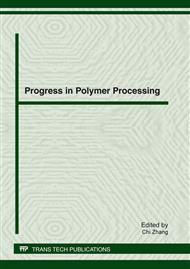p.145
p.151
p.156
p.162
p.168
p.174
p.179
p.185
p.190
Filling-to-Packing Switchover Mode Based on Cavity Pressure for Injection Molding
Abstract:
Filling-to-packing switchover control during injection molding plays a crucial role in ensuring the quality of the molded parts. In this study, a filling-to-packing switchover mode based on cavity pressure was presented, and it was compared with other two switchover modes by injection time and screw position. The objective of this study was to validate the accuracy of the switchover mode based on cavity pressure, and examine its consistency. Weight of the molded parts served as the main measure to probe the process capabilities. In this study, the change in mold temperature was monitored; variation of mold temperature affecting the process was examined. The results of the verification experiments revealed that the switchover mode based on cavity pressure could yield a better part quality and consistent part weight compared with the other two traditional switchover modes. It was proved that the switchover mode by cavity pressure can be used to improve the precision of the injection molding. However, a suitable switchover pressure must be used for achieving such high process capability, and the position to get the pressure signal and mold temperature should also be considered.
Info:
Periodical:
Pages:
168-173
Citation:
Online since:
January 2012
Authors:
Price:
Сopyright:
© 2012 Trans Tech Publications Ltd. All Rights Reserved
Share:
Citation:


